unit3Grammar
- 格式:doc
- 大小:51.50 KB
- 文档页数:3
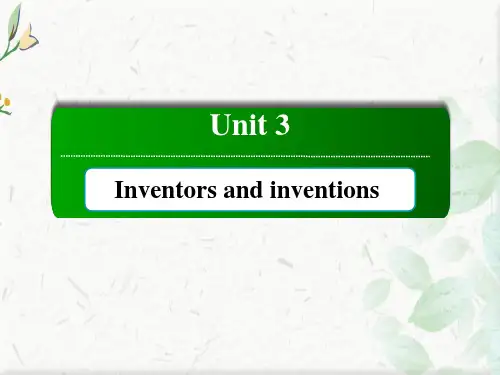
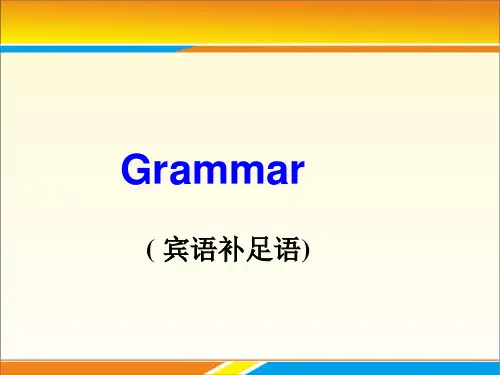
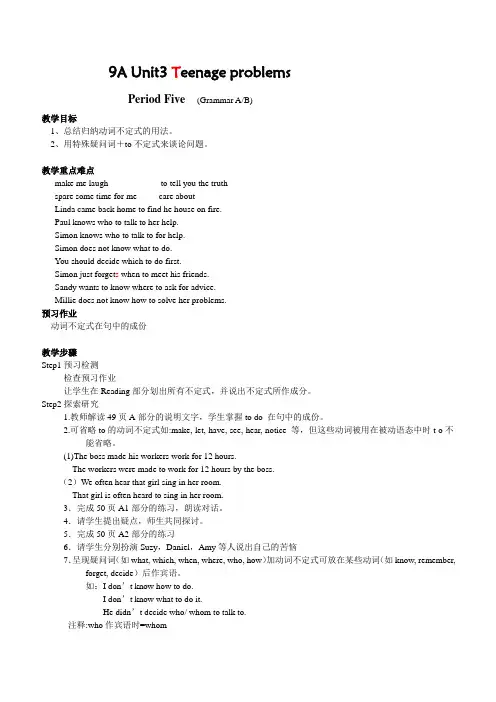
9A Unit3 T eenage problemsPeriod Five (Grammar A/B)教学目标1、总结归纳动词不定式的用法。
2、用特殊疑问词+to不定式来谈论问题。
教学重点难点make me laugh to tell you the truthspare some time for me care aboutLinda came back home to find he house on fire.Paul knows who to talk to her help.Simon knows who to talk to for help.Simon does not know what to do.You should decide which to do first.Simon just forget s when to meet his friends.Sandy wants to know where to ask for advice.Millie does not know how to solve her problems.预习作业动词不定式在句中的成份教学步骤Step1预习检测检查预习作业让学生在Reading部分划出所有不定式,并说出不定式所作成分。
Step2探索研究1.教师解读49页A部分的说明文字,学生掌握to do 在句中的成份。
2.可省略to的动词不定式如:make, let, have, see, hear, notice 等,但这些动词被用在被动语态中时t o不能省略。
(1)The boss made his workers work for 12 hours.The workers were made to work for 12 hours by the boss.(2)We often hear that girl sing in her room.That girl is often heard to sing in her room.3.完成50页A1部分的练习,朗读对话。
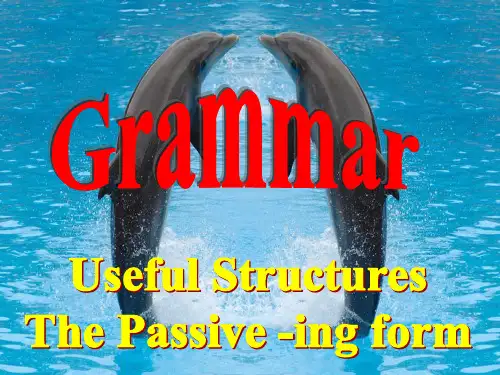

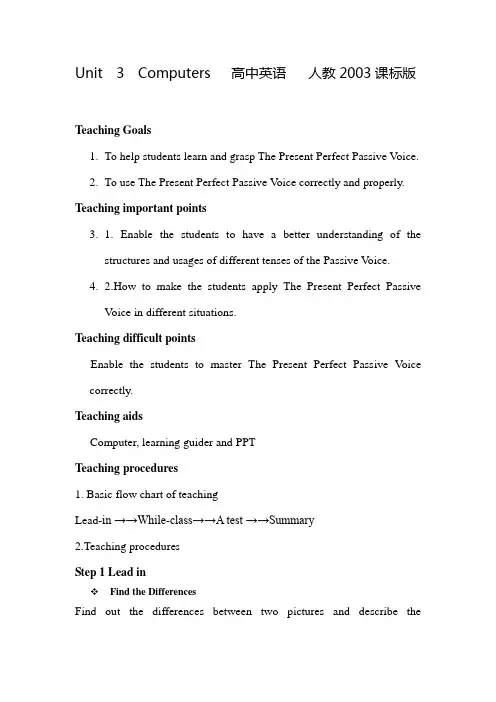
Unit 3 Computers 高中英语人教2003课标版Teaching Goals1.To help students learn and grasp The Present Perfect Passive V oice.2.To use The Present Perfect Passive V oice correctly and properly. Teaching important points3.1. Enable the students to have a better understanding of thestructures and usages of different tenses of the Passive V oice.4.2.How to make the students apply The Present Perfect PassiveV oice in different situations.Teaching difficult pointsEnable the students to master The Present Perfect Passive V oice correctly.Teaching aidsComputer, learning guider and PPTTeaching procedures1. Basic flow chart of teachingLead-in →→While-class→→A test →→Summary2.Teaching procedure sStep 1 Lead inFind the DifferencesFind out the differences between two pictures and describe thedifferences.Pay attention to the sentense structure. (老师先示范,学生模仿)The window has been opened.The painting has been moved.The chairs have been put together.The books have been closed.The dishes have been placed on the desk.The sweater have been taken away.Step 2 RevisionPresent Perfect Tense现在完成时基本结构:主语+ have / has + 过去分词1.表示过去发生的动作对现在造成影响。
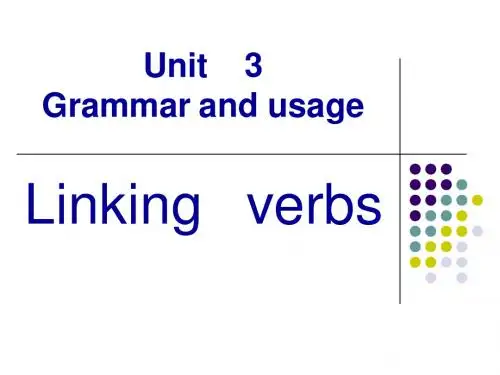


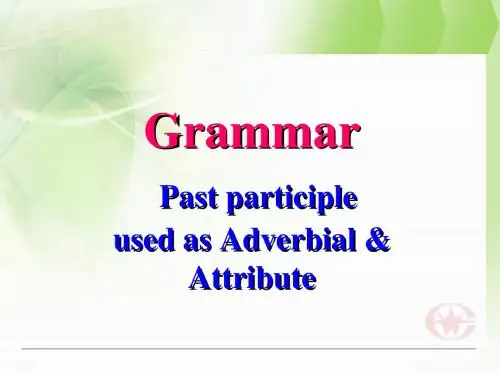
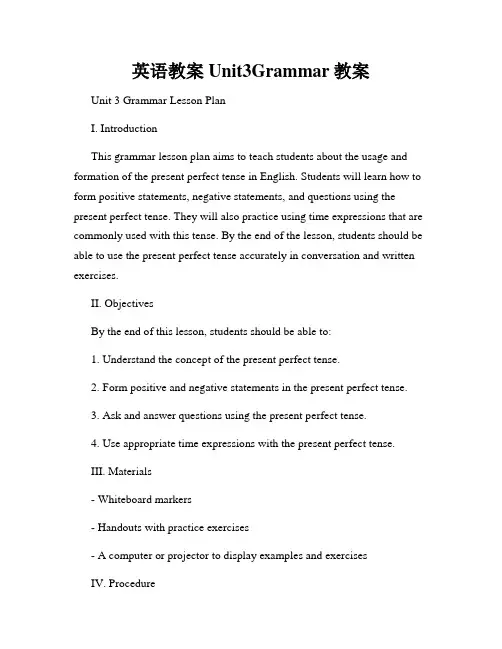
英语教案Unit3Grammar教案Unit 3 Grammar Lesson PlanI. IntroductionThis grammar lesson plan aims to teach students about the usage and formation of the present perfect tense in English. Students will learn how to form positive statements, negative statements, and questions using the present perfect tense. They will also practice using time expressions that are commonly used with this tense. By the end of the lesson, students should be able to use the present perfect tense accurately in conversation and written exercises.II. ObjectivesBy the end of this lesson, students should be able to:1. Understand the concept of the present perfect tense.2. Form positive and negative statements in the present perfect tense.3. Ask and answer questions using the present perfect tense.4. Use appropriate time expressions with the present perfect tense.III. Materials- Whiteboard markers- Handouts with practice exercises- A computer or projector to display examples and exercisesIV. Procedure1. Warm-up (5 minutes)- Begin the lesson by asking the students some questions about their recent experiences, e.g. "Have you ever traveled abroad?" or "Have you ever tried traditional Chinese food?"- Encourage students to share their experiences using the present perfect tense.2. Presentation (15 minutes)- Introduce the present perfect tense by explaining that it is used to talk about past events or experiences that have a connection to the present.- Write on the board: "Subject + have/has + past participle."- Provide examples of positive statements, negative statements, and questions using the present perfect tense.- Highlight the differences between "have" (used with pronouns 'I','you', 'we', and 'they') and "has" (used with the pronouns 'he', 'she', and 'it').3. Practice (20 minutes)- Distribute handouts with practice exercises.- Instruct students to complete the exercises individually.- Monitor their progress and provide assistance when needed.- Review the answers as a class and address any questions or concerns that arise.4. Guided Conversation (15 minutes)- Divide the class into pairs or small groups.- Provide each group with a set of conversation cards with prompts related to the present perfect tense.- Instruct students to take turns asking and answering questions using the present perfect tense.- Monitor their conversations and provide feedback on their usage of the present perfect tense.5. Production Task (20 minutes)- Ask students to write a short paragraph about their own experiences using the present perfect tense.- Encourage them to include at least three different verbs and appropriate time expressions.- Collect and review their paragraphs for accuracy and grammatical errors.6. Wrap-up (5 minutes)- Recap the main points covered in the lesson.- Answer any remaining questions from students.- Assign any additional homework or review activities as necessary.V. AssessmentAssessment during this lesson can be performed through observation of students' participation in the guided conversation activity, accuracy in completing the practice exercises, and the quality of their written paragraph.VI. Homework- Assign students to complete a set of exercises from their textbooks that focus on the present perfect tense.- Instruct them to review the lesson material and practice using the present perfect tense in their daily conversations.Note: This is a sample format for a grammar lesson plan. Adapt and modify it according to your teaching style, the level of the students, and the specific course requirements.。
必修三unit3 Grammar —宾语从句和表语从句一、宾语从句(在复合句中作宾语的从句叫宾语从句。
)1.连接词that 引导的宾语从句that在句中不充当任何句子成分,在口语或非正式文体中常被省去。
①We heard that one more person died in the conflicts of that country.我们听说又有一人在该国的冲突中死亡。
2.连接词whether/if 引导的宾语从句连接词whether/if 作“是否”讲时,常用在ask, care, find out, know, wonder 等动词后常跟带有疑问意义的宾语从句。
从句中仍保持陈述语序,whether或if 不担当句子成分。
②Do you know whether/if any decision has been arrived at?你知道是否已经做出决定了吗?3.连接代词和连接副词引导的宾语从句连接代词who, whom, whose, what, which, whatever, whoever, whomever, whichever连接副词when, where, how, why。
这些连接词都有词义,除引导从句外,还在从句中充当一定的成分,可作主语、宾语、表语、定语、状语等。
这种宾语从句有疑问意义,但不是疑问句,不能用疑问语序,而要用陈述语序。
③She always thinks of how she can work well. 她总是在想怎样把工作做好。
即学即练1 (1-1.根据句意填入适当的连接词)①我们决不能认为自己什么都好,别人什么都不好。
We must never think ______ we are good in everything while others are good in nothing.②我不知道他是否会出席会议。
I don't know _________ he will attend the meeting.③我想知道她去了哪里。
Book 3 Unit 3 Grammar 名词性从句(一)在复合句中起名词作用的句子叫名词性从句(Noun Clauses)。
名词性从句的功能相当于名词词组, 它在复合句中能担任主语、宾语、表语、同位语、介词宾语等,因此根据它在句中不同的语法功能,名词性从句又可分别称为主语从句、宾语从句、表语从句和同位语从句。
一、引导名词性从句的连接词可分为三类:1.连词(5个):它们在从句中均不充当任何成分that (宾语从句或表语从句中that有时可以省略)whether, if (均表示―是否‖,表明从句内容的不确定性)as if ,as though (均表示―好像‖,―似乎‖)2.连接代词(9个):what, whatever, who, whoever, whom, whomever, whose, which, whichever 这些关系代词不仅起到连接一个句子的作用,同时也充当从句中的句子成分。
3.连接副词(7个):when, where, how, why, whenever, wherever, however二、名词性从句中不可省略的连词:1. 介词后的连词2. 引导主语从句和同位语从句的连词不可省略。
That she was chosen made us very happy.We heard the news that our team had won.三、whether与if的用法比较whether与if 均为"是否"的意思。
但在下列情况下,只可用whether:1. whether引导主语从句并在句首2. 引导表语从句3. whether从句作介词宾语4. 从句后有"or not"5. 引导同位语从句6. 后接动词不定式时Whether there is life on the moon is an interesting question.月球上有没有生命是个有趣的问题。
Unit 3 Under the sea
Grammar:Passive -ing form
(New Senior English For China
Student's Book 7)
广东省茂名市茂港区第一中学 黄小容
Teaching Objective:
Help the Ss to master the usage of the Passive -ing form.
Teaching Procedures:
Step 1 Check their homework
Find and underline all the sentences using the -ing form in the reading passage. Get
them to read the sentences aloud one by one.
Step 2 Learning and practising
1.Revise V-ing form and its passive voice.
2.Mark the passive -ing form in red in the sentences they just found out in the text.
3.Analyse in details.(Apperidices P95)
动词-ing形式的被动式
动词-ing形式的被动式, 其构成为 “being+动词的过去分词”, 可在句中作
主语, 表语, 宾语, 宾语补足语, 定语和状语, 但不能单独作谓语, 其完成形式为
having been done, 多在句中作状语。如果动词-ing形式的逻辑主语为所表示的动
作的承受者,动词-ing形式要用被动语态,动词-ing形式的被动语态有一般式与
完成式之分。
4.Get the students to complete the sentences with the passive -ing form of the verbs in
brackets.(Ex 2 P23)
5.Check the answers together and analyse the part of speech of each -ing form in
those sentences.
1.James was afraid of being attacked (attack) by sharks. (Object)
2.Being held up (hold up) in the water by Old Tom, James was confident he would
survive. (Adverbial modifier)
3.Being included (include) in the hunt was a great thrill for Clancy.(Subject)
4.Having been accepted (accept) by the whalers, the killers were able to get a good
feed from the whale.(Adverbial modifier)
5.Clancy didn't mind being told (tell) what to do.(Object)
6.Being helped out (help out) by the killer whales, the whalers were able to make a
successful kill. (Adverbial modifier)
7.The children enjoyed being taken (take) to the aquarium. (Object)
8.It seemed the sea lion didn't mind being photographed (photograph) with the tourists
after all. (Object)
9."In fact, the chances of anybody being swallowed (swallow) by a whale are rather
low," said the researcher. (Attribute)
6.Underline the use of the -ing form in the following passage, marking the passive
-ing form specially.(Ex 3 P23)
Fishing nets in the sea have become a serious problem. They may be many
kilometres long with plastic balls to keep them floating on the water, and weights to
hold them down on the seabed. Unfortunately, the plastic nets are impossible to see
underwater. So the term to describe them is "a wall of death". Their advantage is that
they catch fish efficiently. However, they also cause danger to sea animals. First, not
only target fish are caught in the net, but many other sea animals are found hanging
there. Those not needed for marketing are thrown away. Second, nets are in danger of
being cut loose by fishermen. If a net becomes free-floating, it is moved by the tides
all over the ocean. It behaves as a hidden danger, killing all that are trapped in it. So
many animals being caught in driftnets make many think that it is necessary to have a
worldwide ban on all driftnet fishing.
Step 3 Application
1.Complete each of the following sentences in several ways using the passive -ing
form. Then compare in pairs. (Ex 4 P23)
2.Try to connect the sentences into a short passage.
Step 4 Homework
1.Recite the sentences in Ex 1 P23.
2. 将下列句子翻译成英语。
(1)他受不了别人那样开他的玩笑。
(2)这问题远远没有解决。
(3)没有谁请他做,是他自己做的。
(4)在动手术之前你不能吃任何东西。
(5)既然已做出了决定, 下个问题就是如何制定一个好的计划。
3.Preview Reading and Discussing on P24.